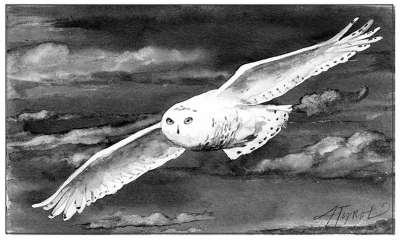
I have been keeping a close watch on my birdfeeders. Not only because I love seeing the juncos and goldfinches that arrive in flocks, and the black-capped chickadees that zip around, and even the blue jays that tend to scare everyone else away, but because I am hoping for some not-so-typical visitors: red crossbills and pine siskins.
Both are year-round residents of northern boreal forests, as well as the Rockies and Pacific Northwest. It’s not unusual to see them in New England in the winter, but every few years, large numbers of them arrive in search of food. These sudden population shifts are known as irruptions. In addition to red crossbills and pine siskins, other irruptive species include evening grosbeaks, redpolls, and perhaps most famously, snowy owls, which have been frequently observed this year.
Irruptions are often driven by food. In the case of the red crossbills and pine siskins, the failure of conifer crops in the West has displaced them from their typical winter grounds. In the case of snowy owls, which spend summers north of the Arctic Circle, last year’s boom in the population of lemmings, voles and other prey led to a wildly successful breeding season. That has resulted in more birds heading south and looking for food.
But exactly how many more birds? What constitutes an irruption? “The lines blur,” said Matt Young, who works for the Cornell Lab of Ornithology’s Macaulay Library. “There's no defined threshold other than larger than usual numbers.”
For example, in the winter of 2007-08, data from Project FeederWatch, a winter survey of birds overseen by the Cornell Lab, noted that pine siskins were present at 24% of their sites in the lower 48 states and the average flock size was about 11 birds. The following year there was an irruption and pine siskins were reported to be at 50% of the sites, in flocks averaging 15 birds.
Irruptions tend to occur every few years among various species. But about once a decade there is a superflight year, when numerous bird species are on the move due to a combination of environmental forces. The Northeast had a superflight year in the winter of 1997-98, said Young, when large numbers of pine grosbeaks, evening grosbeaks, common and hoary redpolls, red crossbills, white-winged crossbills and pine siskins arrived in force.
While those species travel in flocks, snowy owls tend to be solitary. But one is all it takes to create a stir. With their ghostly feathers, yellow eyes and a wingspan of more than four feet, they have an otherworldly look about them.
One of these owls has taken up residence in the coastal town of Rye, New Hampshire and has caused such a commotion that the police are considering ticketing people who disturb the bird or trespass on private property in an effort to catch a glimpse of it.
Closer to my home, a snowy owl was reported on the campus of Vermont Technical College (VTC) in Randolph. Brian Lowe, a bird enthusiast and leader of the Audubon Christmas Day count for Orange County, said it was first spotted in November and was still in the area in mid-January.
Recently, I attended an event in Randolph and took the opportunity for a side visit to the VTC campus. I drove around slowly, looking at the big open fields that border the school, trying to guess the ideal vantage point for a snowy owl. I drove down the road to the Vermont Veterans’ Memorial Cemetery to see if I might have better luck there. The cemetery slopes up a hill and has plenty of coniferous trees that might also draw red crossbills and pine siskins. The open fields next to VTC were within sight.
It was in the low 40’s, sunny and breezy. After weeks of sub-zero nights and single-digit days, the air felt warm and welcoming. I had the place to myself and took pleasure in walking around without a hat or gloves. Every so often I scanned the trees with my binoculars. I didn’t see a single red crossbill, pine siskin or snowy owl. But I loved the idea that I could have.
And still might.

